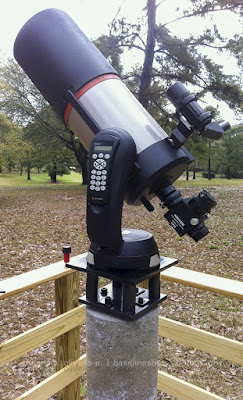 |
The Moon - Nikon D300, Nikon 400mm f2.8 lens w/1.4X TC, ISO 200 @ f16, 1/125th sec.
Background – Nikon D3S, Nikon 17-35mm f2.8 lens, ISO 3200 @ f2.8, 25 sec.
|
This is Part II in my series of posts on Astrophotography. In Part I, I discussed astrophotography that you can do with a DSLR and various photography lenses. In Part II, we'll take it up a notch and get into some basic imaging using a long telephoto/zoom lens or a telescope. If you missed Part I, you can get to it here.
TAKING IT TO
THE NEXT LEVEL
Solar
System Imaging – The Moon
Imaging the solar system is a natural progression from wide-angle
sky images and an easy way to delve deeper into astrophotography.
The moon is an ideal first target and presents a variety of opportunities to create interesting images. The moon has many phases, ranging from a sliver crescent to a complete circular ball of light. Each phase alters the way the topography appears due to the shadow created by the earth. That in turn allows you to experiment with images that have a completely different look when compared to each other.
A tripod as a base will suffice and a full frame DSLR will yield better images than cropped sensor bodies. Added cost will come into play if you lack a long focal length lens. If you're a fan of composite images, using moon shots as background images lend themselves to some interesting creations like these images of airliners I silhouetted in a couple of my moon shots.
A tripod as a base will suffice and a full frame DSLR will yield better images than cropped sensor bodies. Added cost will come into play if you lack a long focal length lens. If you're a fan of composite images, using moon shots as background images lend themselves to some interesting creations like these images of airliners I silhouetted in a couple of my moon shots.
Solar
System Imaging – Planets
 |
| Mars |
Going from moon to planetary photography requires a step up
in equipment. To avoid blurry, faint images of planets, a telescope that has a
focal length of 2000mm or more is needed to achieve the necessary magnification
for these targets.
 |
Jupiter - Nikon D3S, Celestron Nexstar 8 telescope & Televue 4X Powermate.
Ninety images @ ISO 800, f10, 1/10th sec to 1/30th sec.
|
 |
Saturn – Nikon D3S, Celestron Nexstar 8 telescope, Televue 5X Powermate. Ninety images,
ISO 800, f10, 1/2.5 to 1/6th sec. Star field – 17-35mm lens, f2.8, ISO 3200, f2.8, 25 sec.
|
 An investment of $500 or so in a used 8-inch Schmidt
Cassegrain telescope (SCT) will give you the necessary focal length. Celestron
and Meade have been making SCT telescopes for years and are plentiful on the
used market. You can go bigger than an 8" SCT but I have found that anything larger is too heavy and cumbersome to be portable.
An investment of $500 or so in a used 8-inch Schmidt
Cassegrain telescope (SCT) will give you the necessary focal length. Celestron
and Meade have been making SCT telescopes for years and are plentiful on the
used market. You can go bigger than an 8" SCT but I have found that anything larger is too heavy and cumbersome to be portable.
You will also need a T-mount attachment for your camera to
connect a DSLR camera body to the back of the telescope. Finally, a Barlow lens
is a must. Barlow lenses increase magnification without affecting f-stop value.
They come in various magnification factors from 2X to 5X, and while you can
scrimp on these lenses, the only ones I would recommend are Televue Powermates.
These are optimized for photography and are well worth the price tag of
approximately $200 for a new one, less for used ones.
The imaging process is the same as the one described for
shooting the moon with one exception – because of the slower shutter speeds,
use a remote shutter release or the camera’s self timer feature to trigger the
shutter. You should also lock your mirror in the up position. This will minimize
camera vibration that produces blurry images.
Next Up - Part III
In the next post, I'll step it up even more as the discussion will move on to wide field imaging of deep sky targets with telescopes, DSLR's and CCD cameras.




2 comments:
cool. I love space photography
Agree with Paulo, these planetary images are not taken with an 8" sct. That kind of detail can't be had with a 1 meter scope, let alone 8 inches. These are hubble quality, not amateur earth based quality. These are fake images not taken with this setup.
Do a google search for 'Damian Peach planetary', he's pretty much the best planetary imager around, and using bigger scopes his don't look anything like this. The fine detail in these pictures is not possible without multi-million dollar setups using the latest adaptive optics.
Do not believe what you see on this page.
Post a Comment